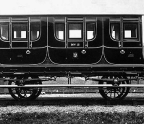
In writing this prologue, the author wishes to acknowledge the wealth of details contained in Chapter 10 of Jeffrey Richards and John M. MacKenzie’s book The Railway Station. The ideas and quotations found in this prologue spring from Chapter 10, which is an excellent exposé dealing with the subject of railway station staff through the nineteenth century and beyond.
From the first sentence it is made clear that workers at stations large and small spent much of their lives there, so that the station became “a permanent feature of their lives”. During the nineteenth century, “The number of people employed by British railway companies rose from 59, 574, in 1850, to 621,340, in 1910”, a good proportion of them working in some capacity at railway stations. Richards and MacKenzie add that “In Britain in 1910, at the peak of the railways’ heyday, 169,572 people worked in stations. This figure comprised 8,688 station masters, 4,163 ticket collectors and examiners, 51,707 porters., 4,695 lad porters, 28,658 signalmen, 13,158 shunters, and 58,503 clerks, male and female.”
Staff selection in Britain was thorough: medical examinations sought good eyesight, physical strength and overall general good health, even as the early 1850s. Most railway companies demanded a degree of literacy (being illiterate was not acceptable) even for lower grades of station personnel. The General Railway Regulation of 1877 “required that a candidate for a porter should be 5 feet 7 inches tall at least, aged between 21 and 35, intelligent, fit, strong, able to read and write, and provided with three character references, one of them from his previous employer”.
Once a person was deemed suitable for railway work, he was expected to have good manners, be




